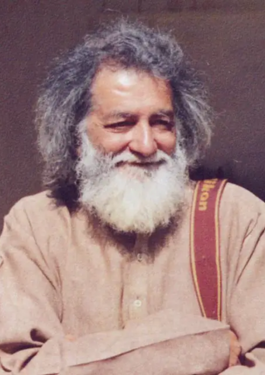
Indian painter Manjit Bawa was born in Dhuri, Punjab, on December 29, 2008, and lived until his death. In 1941, Bawa was born in British India’s Dhuri. He was encouraged to pursue art by his older brothers.
Between 1958 to 1963, he pursued his fine arts studies at the College of Art, New Delhi, where he was taught by B.C. Sanyal, Somnath Hore, Rakesh Mehra, and Dhanaraj Bhagat. “Under Abani Sen, nevertheless, I developed a personality.
Sen would ask me to draw fifty sketches a day, but he would usually turn them down. I thereby ingrained the habit of working nonstop. At a time when the whole scene was tilting toward the abstract, he taught me to value the figurative.
I could never have been able to twist forms and produce the stylization you see in my work now without that early training,” Bawa remembers. Bawa studied art and worked as a silkscreen printer in Britain from 1964 to 1971. “When I came back, I was at a loss for what to paint. I couldn’t be just another copy of a European painting style.”
Instead, he discovered poetry from the Sufi (school of Islam) and stories from Hindu mythology and sociology, such as the Mahabharat, the Ramayan, and the Puranas, as well as poems by Punjabi poet Waris Shah and readings from the Guru Granth Sahib, the holy book of the Sikhs.
The ochre of sunflowers, the green of paddy fields, the red of the sun, and the blue of the mountain sky are the colors that set Manjit Bawa’s canvases apart. He was among the first artists to reject the prevailing shades of gray and brown and use more conventionally Indian hues like violet, pink, and red.
Rather than depicting cows as in mythical art, he had depicted Lord Krishna with a flute surrounded by dogs and Ranjha, the cowherd from the tragic tale Heer Ranjha. Bawa also paints a lot of the Indian gods Kali and Shiva, which he regards as “icons of my country”.
Here, nature serves as inspiration as well. He used to travel a lot when he was younger, either by hitching, riding a bicycle, or walking. “I’ve visited nearly every place, including Gujarat, Rajasthan, and Himachal Pradesh. I used to lay out a piece of paper and sketch the landscape.
I was captivated by the hues and the simplicity of those I encountered.” In his paintings, both animals and birds are frequently depicted, either by themselves or with people. In addition to nature, the flute appears frequently in his compositions.
Pannalal Ghosh taught Bawa how to play the flute. He has shown the tragic love ballad Heer Ranjha’s cowherd, Ranjha, playing the flute. He has shown the tragic love ballad Heer Ranjha’s cowherd, Ranjha, playing the flute.
Instead of the cows that are shown surrounding Krishna in mythological art, he has depicted the god with a flute and dogs. Other than these, Bawa’s canvases are dominated by images of Shiva and Kali, which he considers to be the “icons of my country.”
In addition to his vivid paintings, Bawa is well-known for his devotion to spirituality, especially Sufi philosophy. “I think the scriptures to be incredibly wise. I’ve learned from Sufi philosophy that humans and animals can coexist,” he says.
Throughout his career as an artist, the painter has been embroiled in a number of controversy; the most recent was his helper accusing him of counterfeit. Drawing is Bawa’s first passion. “I like to do it since it’s neither ostentatious or noisy. The artist claims that one can get the greatest impact with the fewest necessary elements.
“After viewing Michelangelo’s sketches and drawings at an exhibition in Amsterdam, where I had gone for one of my shows, I was motivated to pick up drawing again. The thought stayed with me. I believe everything has its proper time and place, so I don’t work on demand—instead, I follow my intuition and heart.”
| Name | Manjit Bawa |
|---|---|
| Also Known as | Manjit Bawa |
| Date of Birth | 01/01/1941 |
| Date of Death | 29/12/2008 |
| Birth Place | Dhuri, Punjab, India |
| Current Residence | Delhi, India |
| Religion | Hindu |
| Nationality | Indian |
| Height | 178 CM |
| Father | |
| Mother | Sharda Bawa |
| Children | Ravi Bawa, Bhavana Bawa |
| Educational Qualification | Graduate |
| Debut Movies | |
|---|---|
| Language | Movie Name |
| Hindi | Dilse |
| Awards List | ||||
|---|---|---|---|---|
| Year | Award | Category | Movie Name | |
